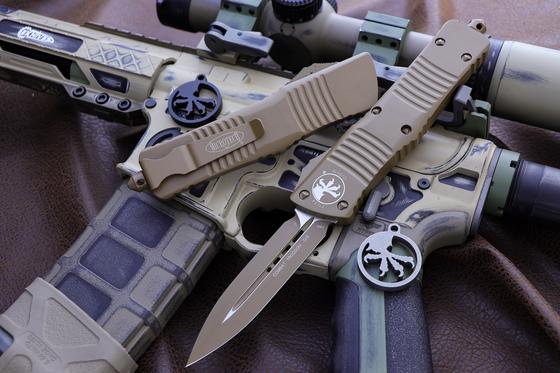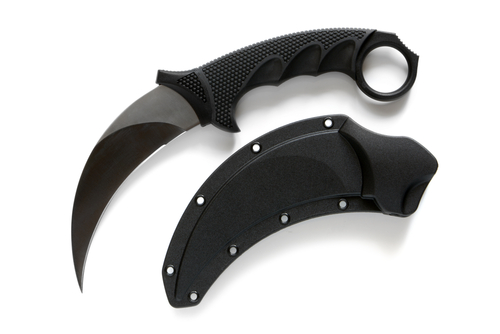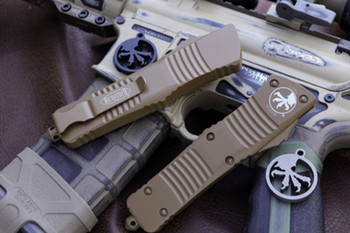Understanding Different Knife Blade Types: Which Blade Shape Is Right for You?
May 24th 2018
The variety of knife styles, shapes and blades can be a bit overwhelming, especially if you're new to knife ownership. It's important to decide what you will be using the knife for, then you can narrow down which blade shape will be most useful for your needs.
Here’s our list of the ten most popular blade types and their uses:
1. Spear Point
Spear point blades are sharpened along some or all of the back side of the blade. The blade can be in the shape of a drop-point, a dagger or a needle. The Combat Troodon is one of the more interesting spear-point type dagger blade knives.
The sharpened back side of the blade makes them useful for stabbing or piercing, but they aren’t as adept for cutting.

2. Drop Point
This is one of the most recognizable styles of blades, especially on folding knives. The back of the blade is unsharpened, while the rest of the blade is sloped with a convex shape. These knives are excellent for any purpose which involves cutting and, while the tip is sharp, they don't pierce or stab things as well as spear point blades.
3. Straight Blade
The straight blade has a blunt back and a curved, sharpened edge. The blunted back allows you to apply pressure with your hand or fingers without fear of cutting yourself.
The straight blade is an excellent choice for everyday use because it stands up to wear and tear. It's useful for slicing and cutting, but not as much for piercing or stabbing.
4. Sheepsfoot/Wharncliffe
The sheepsfoot/Wharncliffe blade is safer than a drop point or clip point and excellent for all-purpose cutting. It has a straight edge with a slightly curved blade toward the front, while the back is dull. The blades are sometimes used interchangeably because they are similar in appearance and style, but the sheepsfoot spine curves slightly while the Wharncliffe spine remains mostly straight up to the point.
These blade styles are favored by first responders who need to cut through materials on a victim quickly without fear of accidentally stabbing or piercing them. The downward-sloping shape of the blade lowers this risk significantly and is effective for cutting or slicing.
5. Clip Point
The clip point is much like the drop point, except that the point of the tip curves upward instead of downward. The back edge of the knife is straight until about mid-way on the blade, and then it suddenly slopes downward, ending in a slightly upward point.
This blade is useful for piercing and slicing, but the point can sometimes break off when a lot of pressure is applied. It's a popular style on most folding knives and can be effective for everyday and survival tasks.
6. Tanto Blade
The tanto is a Japanese short sword which was carried by Samurai warriors. The back of the blade is unsharpened and runs straight to the point. The belly of the blade follows the back until the final third of the blade, where it makes a quick, angular upturn.
The result is a blade with not much belly or cutting power, but a tip that is incredibly powerful for piercing or stabbing sturdy materials. Some tanto blades are serrated to make up for this lack of cutting power, making them more versatile.
7. Serrated blade
Many people find serrations add cutting power to existing knife blade shapes. Serrations create the ability to "saw" through something, with the teeth grabbing the material and holding on during the cut. They are more difficult to sharpen and require a special sharpening tool.
8. Pen Blade
The pen blade looks much like a spear-point, but it is smaller and features a gradual curve around the tip. It is seen most often on Swiss Army knives and is useful for cutting but not for piercing or stabbing. Its size is its most attractive feature, especially for those who want to carry a small knife for convenience or quick tasks.

9. Talon blade
The talon blade is styled after the talons of some of your favorite birds of prey. The back and belly of the blade both curve upward and create a semi-circular shape. This results in a point that is useful for stabbing or piercing. These styles of blades can be effective for self-defense or slashing purposes.
10. Leaf blade
The leaf blade has a straight, unsharpened back with a slightly upward-curved belly, resulting in a resilient point. It is very easy to sharpen because of its shape and is useful for both cutting and piercing or stabbing purposes. While it is not as common as other knife blade styles, some might argue that it is one of the more effective general-purpose blade styles.
Final Thoughts
There are many variations of knife blade types, and each one serves a specific purpose. Even within each knife blade style, there are variations in width, length and design. Take some time to research the different knife blades and see which one will work best for your tasks.

